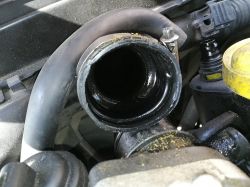FAQ
TL;DR: After 150 km, a Megane 2 1.9 dCi showed blue/white smoke and “revs jumped to the maximum”—classic oil-ingestion runaway. This FAQ helps owners stop it safely and diagnose the cause. [Elektroda, tytan53, post #17192425]
Why it matters: Diesel runaway can destroy the engine quickly, so fast, correct diagnosis prevents catastrophic damage.
Quick Facts
- Typical cause: failed turbo seals dumping oil into the intake, not a head gasket issue. [Elektroda, szymitsu21, post #17192492]
- Hydrolock risk: ingesting oil can bend conrods because “the liquid is incompressible.” [Elektroda, helmud7543, post #17192880]
- Symptom snapshot: self-acceleration at idle, blue/white smoke, oil light, and oil pooling in intercooler piping. [Elektroda, tytan53, post #17192425]
- Quick diagnostic: disconnect intake, top-up oil, start as naturally aspirated; if it runs clean, rebuild/replace turbo and wash intake. [Elektroda, kortyleski, post #17193912]
- Case outcome: new turbo restored power and normal behavior after the failure described. [Elektroda, tytan53, post #17205157]
What are the tell-tale symptoms of turbo oil ingestion on a Megane 1.9 dCi?
Symptoms include loss of power, harsh metallic knocking, and sudden self-acceleration at idle. Expect blue/white exhaust smoke and an oil warning. Oil often appears in intercooler pipes and intake hoses. These signs all showed up together in the reported case. [Elektroda, tytan53, post #17192425]
What component most often causes these exact symptoms?
The turbocharger is the prime suspect. “A damaged turbine throws oil into the intake,” which then fuels uncontrolled combustion. That single fault explains smoke, runaway idle, and loss of power. Replace or rebuild the turbo after inspection. [Elektroda, szymitsu21, post #17192492]
Why does the engine knock or “tap” under these conditions?
Oil entering the cylinders changes combustion timing. “The oil I get in causes knocking combustion,” producing the metallic tapping you hear. The sound can be severe during runaway episodes. Investigate the source of oil before further running. [Elektroda, szymitsu21, post #17192574]
Could the engine be damaged beyond the turbo?
Yes. Large oil ingestion can hydrolock a diesel. “The liquid is incompressible,” so connecting rods can bend under load. Bearings or crankshafts may also suffer damage. If it never fully revved away, the engine may survive with a turbo fix. [Elektroda, helmud7543, post #17192880]
How can I quickly confirm it’s the turbo and not the engine?
Use a simple isolation test.
- Disconnect the intake so the engine runs naturally aspirated.
- Top up oil to the correct level.
- Start and listen; if it idles clean without knocks, fix the turbo and wash the intake. [Elektroda, kortyleski, post #17193912]
Is it safe to keep driving once smoke and runaway symptoms appear?
No. Continuing to drive risks hydrolock and bent rods from incompressible oil. Shut it down and arrange recovery. Running longer can turn a repairable turbo failure into a full engine rebuild. Assess damage only after stopping the oil source. [Elektroda, helmud7543, post #17192880]
What happened when the owner added oil and continued for about 1 km?
Smoke returned and the oil warning reappeared within about one kilometer. That showed the engine was burning oil drawn through the intake. The intercooler and piping already held significant oil. Continuing would have risked a full runaway event. [Elektroda, tytan53, post #17192425]
How do I stop a diesel that won’t shut off with the start/stop button?
Stall it mechanically. Engage a gear and release the clutch while braking to load the engine. The OP selected first and moved to stop it. Avoid opening the hood during a runaway. Focus on a safe controlled stall and recovery. [Elektroda, tytan53, post #17192425]
Do I need to clean the intake and intercooler after replacing the turbo?
Yes. Residual oil in the intake can feed another runaway or smoke episode. After replacing the turbo, wash the intake tract before driving. This removes pooled oil from pipes and the cooler. It also protects your new turbocharger from debris. [Elektroda, kortyleski, post #17193912]
What else holds the turbo after removing the two top bolts?
Expect hidden fasteners. Beyond the two upper bolts, the turbo still attaches to the exhaust and lower supports. The poster noted it still “sticks to something” after freeing the top. Inspect the downpipe clamp and any rear brackets. [Elektroda, tytan53, post #17195711]
Are bearing shells a known weak point after oil-starvation events on the 1.9 dCi?
Yes. One mechanic reported twisted bearing shells after oil loss, calling it the “Standard death 1.9 dCi.” Persistent knock after fixing the turbo suggests bottom-end damage. In that case, plan for a full teardown or replacement engine. [Elektroda, omegolotC30NE, post #17192672]
Will replacing the turbo fix everything?
Often, yes. In this case, a replacement turbo restored normal operation. Still clean the intake and verify no lasting knock. Check oil level and confirm no new smoke. Re-scan for faults after road-testing. [Elektroda, tytan53, post #17205157]
What is the car’s value impact after a turbo failure at high mileage?
Market value drops sharply when a Megane 2 has a failed turbo at this mileage. One member stated, “The price of the car is now very low.” Fixing the turbo first usually improves saleability and price. [Elektroda, kakibara, post #17193692]
Does stable coolant level rule out a head gasket failure here?
It points away from a head gasket. The owner reported correct coolant level, heavy oil consumption, and oil in the intake. Those signs align with turbo oil leakage, not coolant loss. Prioritize turbo and intake inspection. [Elektroda, tytan53, post #17192425]




